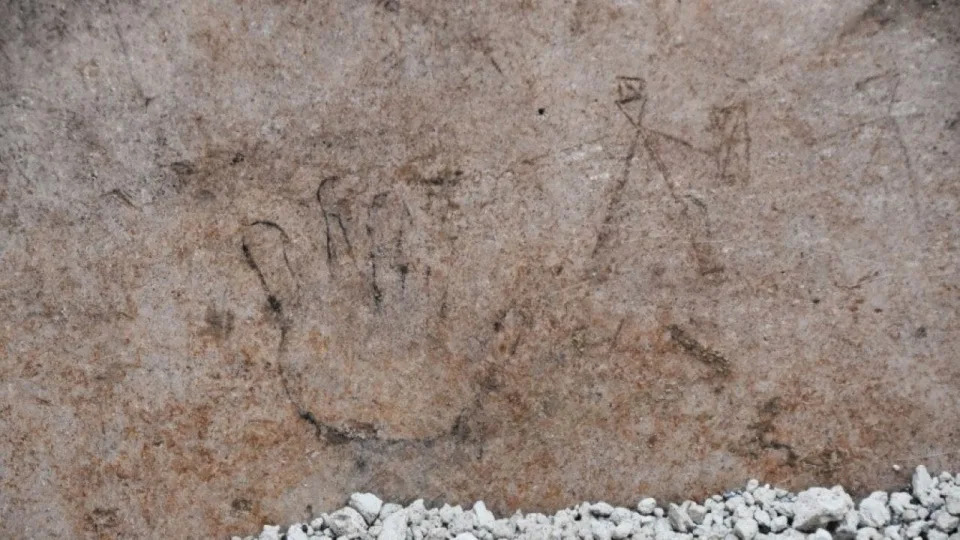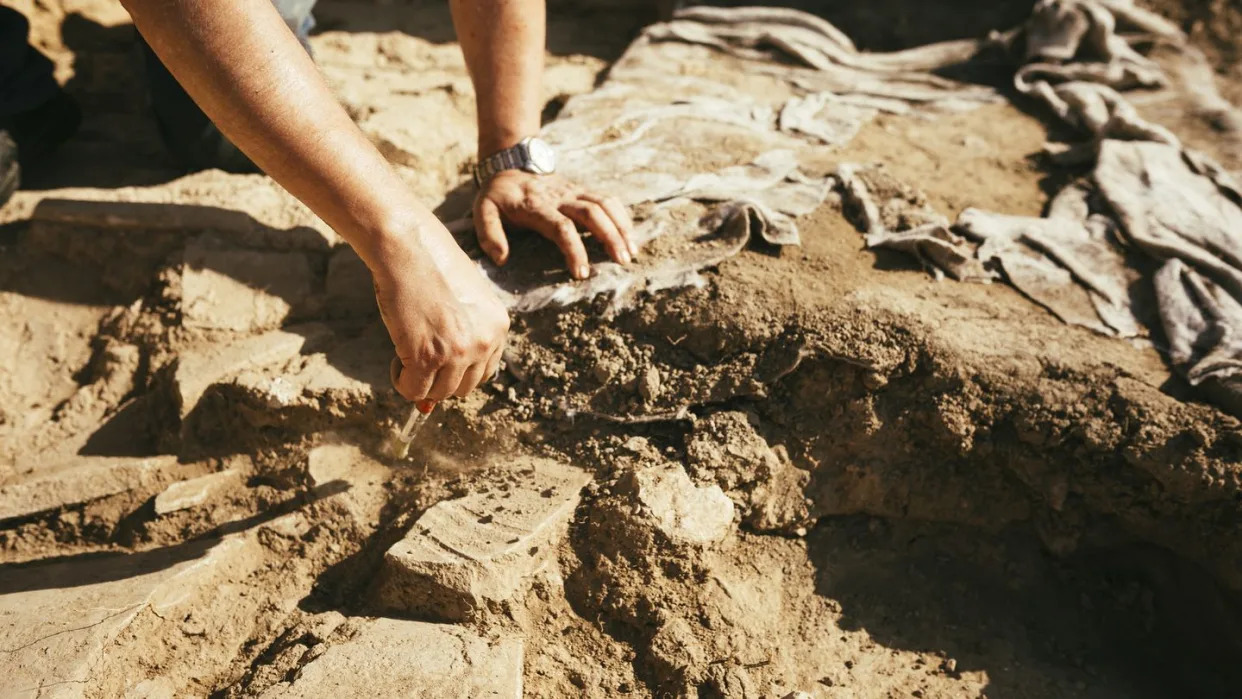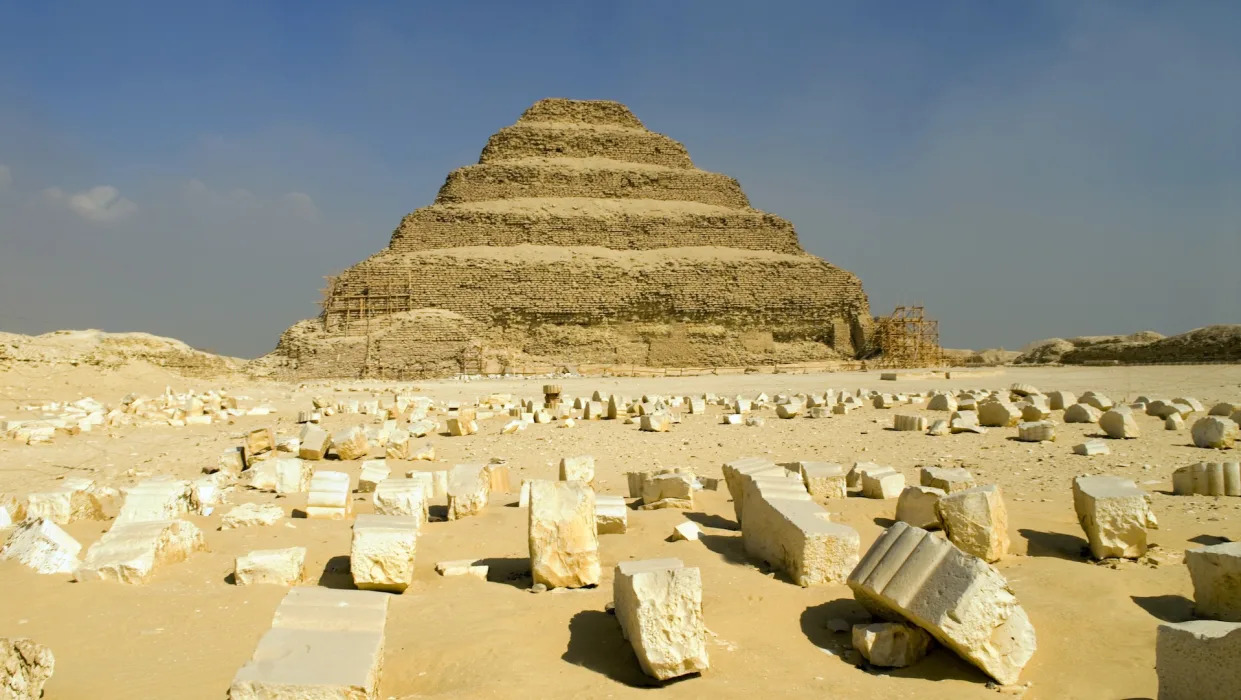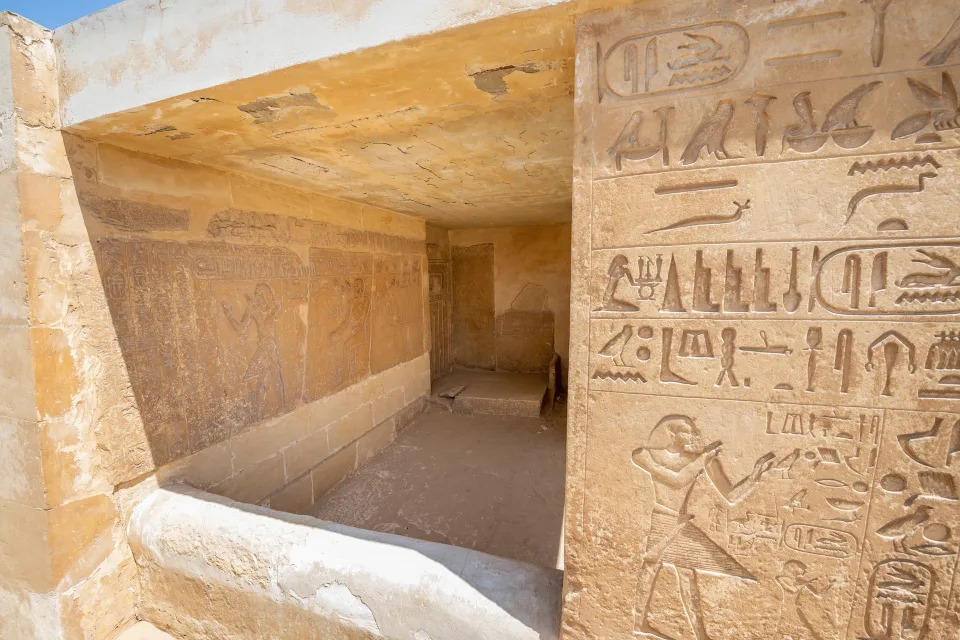Violent doodles made by children 2,000 years ago raise eyebrows
Andrea Vacchiano
FOX NEWS
Sun, June 2, 2024

Violent doodles made by children 2,000 years ago raise eyebrows
Archaeologists in Italy recently uncovered "violent" cartoons, roughly 2,000 years old, drawn by children in ancient Rome.
The Archaeological Park of Pompeii announced the discovery on May 28. The doodles were found on a wall along Via dell'Abbondanza, which was the main street of Pompeii.
Pompeii is an ancient Roman city that was buried by volcanic ash during the eruption of Mount Vesuvius in 79 AD and largely remained hidden for centuries before it was officially rediscovered in the late 16th century.
The charcoal drawings depict gladiators and hunters, and historians say that children were regularly exposed to violence in Roman amphitheaters. In a statement translated from Italian to English, archaeologists connected the violence that children witnessed in antiquity to gruesome images that children see today in popular media.
"Exposure to extreme forms of violence, even of young children (estimated between 5 and 7 years old), does not seem to be a problem only nowadays, between video games and social media," the organization said.

The Archaeological Park of Pompeii announced the discovery of the unusual ancient doodles on May 28.
"The difference [is] that in antiquity, the blood spilled in the arena was real and that few saw it as a 'problem' with all the possible repercussions on the psycho-mental development of children from Pompeii."
In a video posted by the Archaeological Park of Pompeii on May 29, archaeologist Gabriel Zuchtriegel explained in Italian that the cartoons were found in a courtyard, where children likely played.

The drawings depict hunters and gladiators, according to archaeologists.
"We can imagine the children who played here for entire afternoons and had the possibility of making these drawings, perhaps unnoticed by the adults, on various parts of the walls where there was also a construction site where work was in progress on this house," he explained.
Archaeologists collaborated with University of Naples Federico II to determine the significance of the images. Experts concluded that the images reflected what children saw in real life rather than in art or in their imaginations.

Psychologists determined that the children who drew the drawings were exposed to real-life violence.
"We came to the conclusion that these drawings of gladiators and animal hunters were made after a direct vision of the facts, not after a pictorial model," Zuchtriegel said in a video that was later translated to English. "And they are very young children of 6 or 7 years old, as can be seen from the human figures drawn as cephalopods, that is, the legs and arms that come directly out of the head. Even today, little children draw like this."
"It is understood that here in Pompeii, even very young children were exposed to an extreme form of violence between men, between men and animals in the arena, in the amphitheater of the ancient city," the expert added.
Sun, June 2, 2024

Violent doodles made by children 2,000 years ago raise eyebrows
Archaeologists in Italy recently uncovered "violent" cartoons, roughly 2,000 years old, drawn by children in ancient Rome.
The Archaeological Park of Pompeii announced the discovery on May 28. The doodles were found on a wall along Via dell'Abbondanza, which was the main street of Pompeii.
Pompeii is an ancient Roman city that was buried by volcanic ash during the eruption of Mount Vesuvius in 79 AD and largely remained hidden for centuries before it was officially rediscovered in the late 16th century.
The charcoal drawings depict gladiators and hunters, and historians say that children were regularly exposed to violence in Roman amphitheaters. In a statement translated from Italian to English, archaeologists connected the violence that children witnessed in antiquity to gruesome images that children see today in popular media.
"Exposure to extreme forms of violence, even of young children (estimated between 5 and 7 years old), does not seem to be a problem only nowadays, between video games and social media," the organization said.

The Archaeological Park of Pompeii announced the discovery of the unusual ancient doodles on May 28.
"The difference [is] that in antiquity, the blood spilled in the arena was real and that few saw it as a 'problem' with all the possible repercussions on the psycho-mental development of children from Pompeii."
In a video posted by the Archaeological Park of Pompeii on May 29, archaeologist Gabriel Zuchtriegel explained in Italian that the cartoons were found in a courtyard, where children likely played.

The drawings depict hunters and gladiators, according to archaeologists.
"We can imagine the children who played here for entire afternoons and had the possibility of making these drawings, perhaps unnoticed by the adults, on various parts of the walls where there was also a construction site where work was in progress on this house," he explained.
Archaeologists collaborated with University of Naples Federico II to determine the significance of the images. Experts concluded that the images reflected what children saw in real life rather than in art or in their imaginations.

Psychologists determined that the children who drew the drawings were exposed to real-life violence.
"We came to the conclusion that these drawings of gladiators and animal hunters were made after a direct vision of the facts, not after a pictorial model," Zuchtriegel said in a video that was later translated to English. "And they are very young children of 6 or 7 years old, as can be seen from the human figures drawn as cephalopods, that is, the legs and arms that come directly out of the head. Even today, little children draw like this."
"It is understood that here in Pompeii, even very young children were exposed to an extreme form of violence between men, between men and animals in the arena, in the amphitheater of the ancient city," the expert added.

The drawings shed light on childhood in ancient Rome.
Thanks to the discovery, the Archaeological Park of Pompeii said the drawings "help to better understand childhood in the times of Ancient Romans."
Fox News Digital reached out to the Archaeological Park of Pompeii for comment.
Archaeologists Found Stunning Treasure Buried by a Mysterious Forgotten Tribe
Darren Orf
Mon, June 3, 2024

Experts Find Objects from 2,000-Year-Old SocietyJordi Salas - Getty Images
The Kangju people lived in Central Asia (southern Kazakhstan) for nearly a millennia, but experts know very little about them.
A new discovery of artifacts, recovered from a 2,000-year-old burial mound, shows off this little-known society’s sophistication and its deep connections to the ancient Silk Road.
Featuring a brass mirror from China and a Roman-style brooch, this treasure trove reveals the intimate evidence of the world’s first major attempt at globalization.
For around 800 years (from the 4th century BCE to the 4th century CE), a people group known as the Kangju flourished in what is now southern Kazakhstan. Despite this relatively long reign in Central Asia, the knowns of this ancient society are far outweighed by the unknowns. Experts know, for example, that the people had Indo-European origins, spoke an Eastern Iranian language, and likely practiced a semi-nomadic way of life—a common choice among people groups in Central Asian and the Eurasian steppe. Everything else has been slowly pieced together from pottery and other artifacts left behind for us to find.
Now, a new treasure trove of artifacts has been discovered in 2,000-year-old burial mounds in the ancient Kangju region. These items include jewelry, arrowheads, and a large bronze mirror—all of which speak to the Kangju’s sophistication. Kazakhstan lies at the heart of what would’ve been the ancient Silk Road, and the items reflect the impact of this ancient-world globalization.
The mirror, for example, has been traced to the craftsmen of China’s Han Dynasty, which reigned from 206 BCE to 220 CE. Similar mirrors have been found among the discarded detritus of other civilizations along the ancient Silk Road, likely meaning that the woman buried with the mirror was someone of considerable wealth or importance. However, China wasn’t the Kangju’s only trading partner—the ancient people likely also traded with the Roman Empire and the Kushan Empire, another Central Asian power to the south.
To uncover these items, a team of experts from Ozbekali Zhanibekov University—located in the city of Shymkent along the border with Uzbekistan—and local government archaeologists traveled to three burial mounds in the oblast (administrative region) of Turkistan.
As is often the case when exploring ancient ruins, two of the mounds had already been plundered, likely during medieval times. But the third mound still had ancient wonders lying in wait. According to a press release translated from Kazakh language, experts also found other items—including ornate earrings, a belt buckle, and a Roman brooch—that once again emphasized the mound’s advantageous position along the Silk Road.
The leader of this archeological expedition, Ozbekali Zhanibekov University’s Aleksandr Podushkin, said that the Yangju were actually comprised of many different people, including the Asian Sarmatians, the Xiongnu, the Kangyu, and the subsequent Saki (who were, possibly, the famous Scythians). Podushkin has published some 90 articles related the peoples of southern Kazakhstan, and some of his previous work involved analyzing the religious beliefs of the Kangju from artifacts gathered from Ugam Valley, which is also located in the Turkistan region.
Now, these relics will travel to the capital city of Astana and be housed in the National Museum of the Republic of Kazakhstan. As experts like Podushkin continue to find these hidden treasures, over time, the largely blurry image of this people group of Central Asia should slowly begin to come into focus.
Why are so many ancient Egyptians buried at the Saqqara necropolis?
Owen Jarus
POP MECH
Sun, June 2, 2024

The Step Pyramid with a blue sky in the background.
Saqqara is an archaeologist's dream, being home to a vast number of ancient Egypt's mummies, tombs and around a dozen pyramids. Every year, researchers unearth new discoveries at the site, including mummy masks, Book of the Dead scrolls and even mummification workshops.
But why did so many ancient Egyptians want to be buried there?
Saqqara has been used for thousands of years and "the reasons for being buried at the site differed through time," Nico Staring, an Egyptologist and guest researcher at Leiden University, told Live Science in an email.
One important reason is its proximity to the city of Memphis. "Saqqara was the main necropolis associated with the capital city of Memphis, which remained, to a large extent, an administrative centre throughout Egypt's history as well as being a major religious centre celebrating the cults of a variety of deities" Salima Ikram, a professor of Egyptology at the American University in Cairo, told Live Science in an email.
It's hard to overstate the importance of Memphis to Saqqara, Staring said.
"Saqqara should be viewed as a component of the wider, lived urban environment" he said. "The living inhabitants of Memphis shaped and reshaped the necropolis over many generations, and so the life histories of both the city and its necropolis were closely intertwined."
Related: Did the ancient Egyptians really marry their siblings and children?
Sun, June 2, 2024

The Step Pyramid with a blue sky in the background.
Saqqara is an archaeologist's dream, being home to a vast number of ancient Egypt's mummies, tombs and around a dozen pyramids. Every year, researchers unearth new discoveries at the site, including mummy masks, Book of the Dead scrolls and even mummification workshops.
But why did so many ancient Egyptians want to be buried there?
Saqqara has been used for thousands of years and "the reasons for being buried at the site differed through time," Nico Staring, an Egyptologist and guest researcher at Leiden University, told Live Science in an email.
One important reason is its proximity to the city of Memphis. "Saqqara was the main necropolis associated with the capital city of Memphis, which remained, to a large extent, an administrative centre throughout Egypt's history as well as being a major religious centre celebrating the cults of a variety of deities" Salima Ikram, a professor of Egyptology at the American University in Cairo, told Live Science in an email.
It's hard to overstate the importance of Memphis to Saqqara, Staring said.
"Saqqara should be viewed as a component of the wider, lived urban environment" he said. "The living inhabitants of Memphis shaped and reshaped the necropolis over many generations, and so the life histories of both the city and its necropolis were closely intertwined."
Related: Did the ancient Egyptians really marry their siblings and children?

Old Kingdom tomb at Saqqara. It has hieroglyphics on the wall.
Saqqara was also revered because some early Egyptian pharaohs built their tombs there. During the second dynasty (circa roughly 2800 to 2650 B.C.) the pharaohs Hotepsekhemwy, Reneb and Ninetjer all constructed tombs at the site, Lara Weiss, CEO of the Roemer and Pelizaeus Museum in Germany, told Live Science in an email. The third dynasty pharaoh Djoser famously constructed a step pyramid at Saqqara, and several other pharaohs, such as the fifth dynasty pharaohs Userkaf, Unas and Djedkare Isesi, also built pyramids at the site.
As the pharaohs were buried, "large numbers of their court officials constructed their so-called mastaba tombs in their vicinity," Staring added, explaining that the grounds weren't just for royalty.
Even in the New Kingdom (circa 1550 to 1070 B.C.), a time when pharaohs were buried in the Valley of the Kings about 300 miles (483 kilometers) away, many officials still wanted to be buried at Saqqara. This happened because of the site's history and association with Egyptian deities, Staring said. While "the kings were buried in the Valley of the Kings in Thebes, the kingdom's most important administrators built their temple-shaped tombs at Saqqara, at a site that was imbued with history and a site that was considered to be the abode of various prominent deities such as Sokar, a god of death," Staring said.
The Step Pyramid of Djoser was particularly well regarded long after it was built. "Interestingly, old monuments from the past continued to exert influence on later generations," Staring said. Even when it was 1,000 years old, the Step Pyramid complex "received literate visitors that perpetuated their admiration for the monument in graffiti written on the walls of the complex." Staring said.
Living legacy
Although it is an ancient place, Saqqara is still an active burial site today. "Saqqara continues to be used as a burial ground, albeit to a much lesser extent, into the present," Ikram said.
The importance of Saqqara "diminished dramatically" as Christianity became the main religion in Egypt during the fourth and fifth centuries, Ikram noted. But even with the decline of Egypt's polytheistic religion, Saqqara still saw some use — for example, the Coptic Monastery of Jeremiah was built at the site in the fifth century, Weiss noted.
Today, the site is abuzz with archaeologists and tourists. "As a place of the living rather than the dead, the site is today more alive than ever," Staring said.
Historic Finds in Wisconsin Lake Raise More Questions About the Area's Past
Chris Malone Méndez
MENS JOURNAL
Sat, June 1, 2024

Since 2021, archaeologists have been excavating Wisconsin's Lake Mendota and finding some priceless remnants of the past. As they continue to find more dilapidated artifacts, they're left with some new questions about the area's history.
Two canoes were found in the Mendota lakebed in 2021 and 2022, and last week, the Wisconsin Historical Society announced it had found discovered fragments of at least eight more canoes in the lake. They're believed to be between 800 and 4,500 years old, far older than the estimated 1,200-year-old and 3,000-year-old precious discoveries.
Scientists also found other equipment like fishing nets and tools. With the canoes' location on a now-submerged shoreline, the discoveries imply the existence of a previously unknown civilization that thrived in the area in present-day Madison.
"Seeing these canoes with one's own eyes is a powerful experience, and they serve as a physical representation of what we know from extensive oral traditions that Native scholars have passed down over generations," Bill Quackenbush, the tribal historic preservation officer for the Ho-Chunk Nation, said in the Wisconsin Historical Society statement. "We are excited to learn all we can from this site using the technology and tools available to us, and to continue to share the enduring stories and ingenuity of our ancestors."
It's an exciting discovery that is raising more questions about just who and what existed here thousands of years ago.
"We have a lot to learn from the Mendota canoe site, and the research happening today allows us to better understand and share the stories of the people who lived here and had a thriving culture here since time immemorial," Larry Plucinski, the tribal historic preservation officer for the Bad River Band of Lake Superior Chippewa, said of the finds.
Because of the fragile nature of these ancient canoes, the Wisconsin Historical Society isn't planning to recover any other canoes from the site. For now, the experts are thrilled to be exploring some long-standing questions more deeply.
"It is an honor for our team to work alongside the Native Nations to document, research and share these incredible stories from history," state archaeologist with the organization Dr. Amy Rosebrough said of the effort. "What we thought at first was an isolated discovery in Lake Mendota has evolved into a significant archaeological site with much to tell us about the people who lived and thrived in this area over thousands of years and also provides new evidence for major environmental shifts over time."
Sat, June 1, 2024

Since 2021, archaeologists have been excavating Wisconsin's Lake Mendota and finding some priceless remnants of the past. As they continue to find more dilapidated artifacts, they're left with some new questions about the area's history.
Two canoes were found in the Mendota lakebed in 2021 and 2022, and last week, the Wisconsin Historical Society announced it had found discovered fragments of at least eight more canoes in the lake. They're believed to be between 800 and 4,500 years old, far older than the estimated 1,200-year-old and 3,000-year-old precious discoveries.
Scientists also found other equipment like fishing nets and tools. With the canoes' location on a now-submerged shoreline, the discoveries imply the existence of a previously unknown civilization that thrived in the area in present-day Madison.
"Seeing these canoes with one's own eyes is a powerful experience, and they serve as a physical representation of what we know from extensive oral traditions that Native scholars have passed down over generations," Bill Quackenbush, the tribal historic preservation officer for the Ho-Chunk Nation, said in the Wisconsin Historical Society statement. "We are excited to learn all we can from this site using the technology and tools available to us, and to continue to share the enduring stories and ingenuity of our ancestors."
It's an exciting discovery that is raising more questions about just who and what existed here thousands of years ago.
"We have a lot to learn from the Mendota canoe site, and the research happening today allows us to better understand and share the stories of the people who lived here and had a thriving culture here since time immemorial," Larry Plucinski, the tribal historic preservation officer for the Bad River Band of Lake Superior Chippewa, said of the finds.
Because of the fragile nature of these ancient canoes, the Wisconsin Historical Society isn't planning to recover any other canoes from the site. For now, the experts are thrilled to be exploring some long-standing questions more deeply.
"It is an honor for our team to work alongside the Native Nations to document, research and share these incredible stories from history," state archaeologist with the organization Dr. Amy Rosebrough said of the effort. "What we thought at first was an isolated discovery in Lake Mendota has evolved into a significant archaeological site with much to tell us about the people who lived and thrived in this area over thousands of years and also provides new evidence for major environmental shifts over time."
No comments:
Post a Comment